1. Campanula latifolia (1-3)
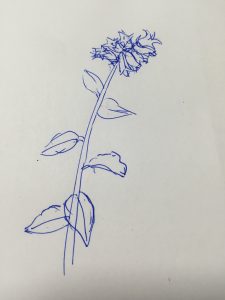
Scientific name: Campanula latifolia
Common name: broadleaf bellflower
Family name: Campanulaceae
Type:Herbaceous perennial
USDA hardiness zone: 4-8
Form: tall, upright, clumping. height: 1-1.5m
Leaf: Toothed, hairy, medium green leaves. Leaves become smaller, narrower as they go up the stems.
Flower: Large, tubular, bell-liked, purplish-blue flowers appear in early summer.
Ecological characteristics/requirements:
- Easily grown in well-drained soil in full sun to part shade.
- Prefers full sun in cool northern climates and part shade in hot summer climates.
- Needs regular moisture.
- Spreads freely and aggressively by both rhizomes and self-seeding under optimum growing conditions. Cut back stems after flowering to promote later re-bloom and to prevent any unwanted self-seeding.
Suitable uses: Best naturalised in open woodland areas, wild areas, cottage gardens or at the rear of borders. Group or mass for best effect.
Quick ID: hairy stems. tubular, bell-liked, purplish-blue flowers
Photographs:
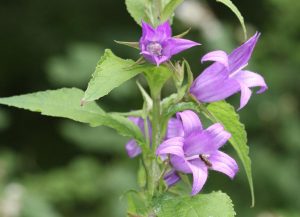
(From: http://www.naturespot.org.uk/species/giant-bellflower)
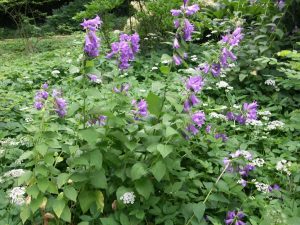
(From: http://ifp.rz.tu-bs.de/geobot/virt-exkursion/exk_06/109.jpg)
Sources of information:
http://www.missouribotanicalgarden.org/PlantFinder/PlantFinderDetails.aspx?kempercode=a941
2. Geranium psilostemon (1-7)

Scientific name: Geranium psilostemon
Common name: Armenian cranesbill
Family name: Geraniaceae
Type:Herbaceous perennial
USDA hardiness zone: 4-9
Form: spreading clumps; height: 30-50cm
Leaf: Fan-shaped leaves, turn red and yellow in fall.
Flower: Vivid magenta 5-petal flowers with black centres, black veining.
Ecological characteristics/requirements:
- Grow in ordinary garden soil, moist but well-drained, in sun or part shade.
- It may need staking if grown alone, but if mixed with roses or other shrubs, it will find its own support.
Suitable uses: mixed well in borders with roses in the pink to purple range and with gray/silver foliage plants such as artemesia.
Quick ID: Fan-shaped leaves and bright magenta flowers with black centres.
Photographs:
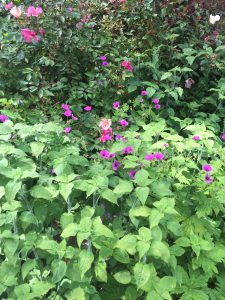
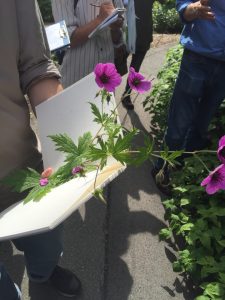
Sources of information:
3. Iris latifolia (1-11)
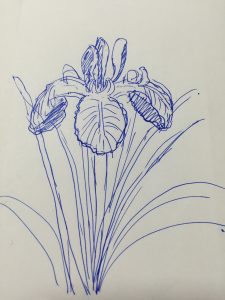
Scientific name: Iris latifolia
Common name: English iris
Family name: Iridaceae
Type:bulb
USDA hardiness zone: 7-10
Form: Clumping; height: 60cm
Leaf: Narrowly lance-shaped leaves, erect and arching
Flower: Attractive, deep purplish-blue flowers with 3 upright standards and 3 round falls with a yellow stripe. Bloom for 3-4 weeks in summer
Ecological characteristics/requirements:
- Easily grown in moist, well-drained soil in full sun.
- Tolerate summer heat
Suitable uses: Specimen or masses in mixed borders or beds.
Quick ID: Deep purplish-blue with 3 upright standards and 3 round falls with a yellow stripe.
Photographs:
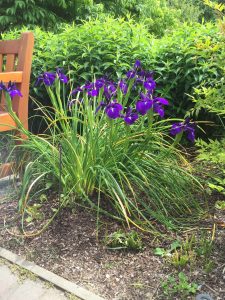
Sources of information:
http://www.kew.org/science-conservation/plants-fungi/iris-latifolia-english-iris
4. Rodgersia aesculifolia (1-18)

Scientific name: Rodgersia aesculifolia
Common name: chestnut-leaved rodgersia
Family name: Saxifragaceae
Type:Herbaceous perennial
USDA hardiness zone: 5-7
Form: bold, clumping; height: 1-1.5m
Leaf: Large, palmately-compound, dark green leaves; some with brown tinting
Flower: From June to August, creamy white to light pink flowers bloom in large, terminal panicles; fragrant.
Ecological characteristics/requirements:
- Native to China
- Best grown in rich, humusy, consistently moist soils in part shade.
- Propagate by division or seed.
Suitable uses: Grows well in moist woodland gardens, bog gardens, water garden peripheries or along stream banks.
Quick ID: Chestnut-leaved foliage; large panicles of creamy white to light pink flowers
Photographs:
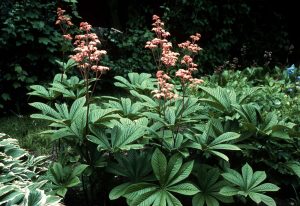
(From: http://searcharchives.vancouver.ca/rodgersia-aesculifolia)

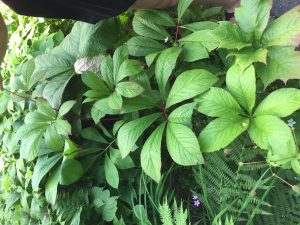
Sources of information:
http://www.missouribotanicalgarden.org/PlantFinder/PlantFinderDetails.aspx?kempercode=d108
5. Artemisia ludoviciana ‘Silver King’ (2-4)

Scientific name: Artemisia ludoviciana ‘Silver King’
Common name: Silver King mugwort
Family name: Asteraceae
Type:Herbaceous perennial
USDA hardiness zone: 4-9
Form: weedy erect; height: 60-90cm
Leaf: Aromatic, sage-like, lance-shaped, silver grey leaves
Flower: Tiny, yellowish-gray flower heads in dense panicles at the stem tops; bloom in summer.
Ecological characteristics/requirements:
- Best grown in excellent well-drained soils in full sun.
- Plants may spread aggressively in the garden by rhizomes and by self-seeding. Prompt removal of flower heads and soil barriers may be considered to help contain spread.
Suitable uses: Silver-green foliage provides excellent contrast in gardens.Good selection for areas with poor dry soils. Invasive habit discourages use of this plant in borders or herb gardens.
Quick ID: silver grey glabrous leaves
Photographs:
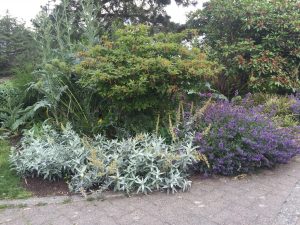

Sources of information:
http://www.missouribotanicalgarden.org/PlantFinder/PlantFinderDetails.aspx?kempercode=a405
6. Kniphofia hybrid (2-14)
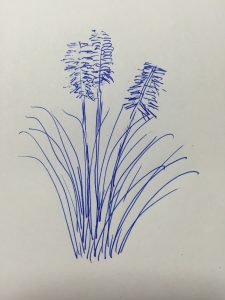
Scientific name: Kniphofia hybrid
Common name: torch lily
Family name: Xanthorrhoeaceae
Type:Herbaceous perennial
USDA hardiness zone: 6-9
Form: Clumping; height: 0.6-1m
Leaf: Coarse, strap-shaped, linear leaves
Flower: Terminal, spike-like racemes of dense, short-stalked, tubular flowers; bloom from late spring to summer. Numerous cultivars with different flower colors including red, orange, pink, yellow, white.
Ecological characteristics/requirements:
- Best grown in humus-rich, evenly moist, very well-drained soils in full sun. Grows well in sandy soils.
- Intolerant of wet, heavy soils, light shade.
- Established clumps are best left undisturbed.
- Hummingbirds like this plant
Suitable uses: Outstanding vertical accent. Effective specimen. Small groups in perennial borders.
Quick ID: linear strap-shaped basal leaves and showy bottlebrush-like flower spikes.
Photographs:

Sources of information:
7. Lychnis coronaria (2-17)
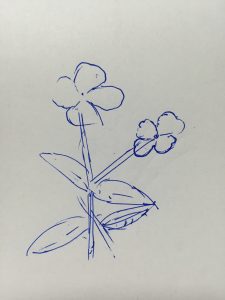
Scientific name: Lychnis coronaria
Common name: rose campion
Family name: Caryophyllaceae
Type:Herbaceous perennial
USDA hardiness zone: 4-8
Form: Clumping; height: 0.5-1m
Leaf: Basal clumps of ovate, woolly, silver-gray leaves
Flower: 5-petal, vivid rose magenta flowers bloom from late spring to early summer
Ecological characteristics/requirements:
- Easily grown in well-drained soil in full sun. Prefers moist soil, but will tolerate poor soils with some dryness.
- A short-lived perennial that may be best grown as a biennial or annual.
- Freely self-seeds. Deadheading flowers from plant immediately after bloom will prevent any unwanted self-seeding.
Suitable uses: Excellent foliage and flower colors make it a good contrast perennial in borders, wild gardens, cottage gardens or meadows. May be used as an accent or specimen.
Quick ID: Rose magenta flowers over woolly, silver-gray leaves
Photographs:
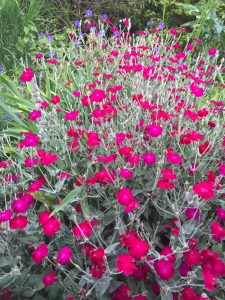
Sources of information:
http://www.missouribotanicalgarden.org/PlantFinder/PlantFinderDetails.aspx?kempercode=p840
8. Stachys byzantina (2-21)

Scientific name: Stachys byzantina
Common name: lamb’s ears
Family name: Lamiaceae
Type:Herbaceous perennial
USDA hardiness zone: 4-8
Form: Spreading; height: 30-50cm
Leaf: Thick, soft, woolly, silver-gray leaves
Flower: Terminal spikes of insignificant, tiny, purplish-pink flowers appear in summer
Ecological characteristics/requirements:
- Easily grown in average, dry to medium, well-drained soil in full sun.
- Drought tolerant.
- Avoid overhead watering.
Suitable uses: Foliage provides interesting texture and color to the border or rock garden. Effective edger or small area ground cover.
Quick ID: Lamb’s ear-liked foliage
Photographs:
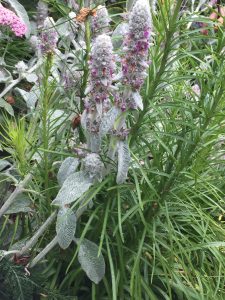
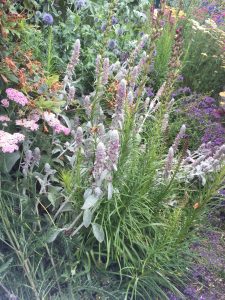
Sources of information:
http://www.missouribotanicalgarden.org/PlantFinder/PlantFinderDetails.aspx?kempercode=p980
9. Alchemilla mollis (3-2)

Scientific name: Alchemilla mollis
Common name: lady’s mantle
Family name: Rosaceae
Type:Herbaceous perennial
USDA hardiness zone: 3-8
Form: Clumping; height: 30-50cm
Leaf: Long-stalked; circular, toothed, pleated, grey green leaves; each with 9-11 shallow rounded lobes. leaves can retain moisture beads.
Flower: Tiny, no-petal, star-shaped, yellow flowers in loose, spreading clusters; bloom in late spring to early summer.
Ecological characteristics/requirements:
– Easily grown in medium moisture, well-drained soils in full sun to part shade. Tolerates close to full shade. Performs well in moist garden areas.
– Freely self-seeds in the garden to the point of being somewhat invasive in optimum growing conditions. Prompt removal of spent flower stems will not only prevent self-seeding but may also encourage a sparse, late summer rebloom.
Suitable uses: Border fronts. Cottage gardens. Edging for paths. Mass as groundcover.
Quick ID: Scallop-liked leaves can retain moisture beads; tiny, star-shaped, yellow flowers
Photographs:

(From: http://ducoeuraujardin.forumzen.com/t1131-alchemilla-mollis-alchemille)

(From http://www.perennials.com/plants/alchemilla-mollis.html)
Sources of information:
http://www.missouribotanicalgarden.org/PlantFinder/PlantFinderDetails.aspx?kempercode=b210
10. Astilbe x arendsii (3-3)

Scientific name: Astilbe x arendsii
Common name: florist’s spirea
Family name: Saxifragaceae
Type:Herbaceous perennial
USDA hardiness zone: 4-9
Form: Soft mounded; height: 0.5-1m
Leaf: Pinnately compound, medium green foliage
Flower: Delicate, feathery of tiny colorful flowers bloom on dense plume-like panicles on erect flower stems, from late spring to late summer. Depending on variety, blooms in shades of red, pink, white, purple and peach.
Ecological characteristics/requirements:
– Prefers shady, moist sites. Can grow in direct sun with constant moisture. With more moisture, blooms last longer
– requires fertile, well-drained soil
– deer resistant
Suitable uses: Fantastic when in mass. Border or edging in woodland gardens or waterside. Containers or cut flower.
Quick ID: plumes of dense, tiny blooms
Photographs:

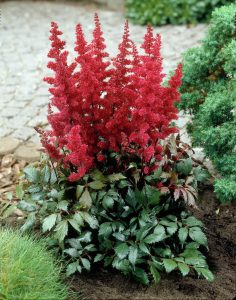
(From: https://www.99roots.com/en/plants/false-spirea-fanal-p32592)
Sources of information:
http://www.gardening.cornell.edu/homegardening/scene4f95.html
11. Hakonechloa macra ‘Aureola’ (3-10)
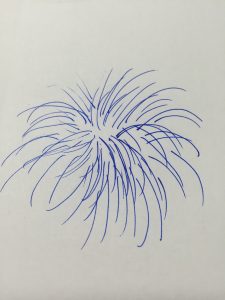
Scientific name: Hakonechloa macra ‘Aureola’
Common name: golden hakone grass
Family name: Poaceae
Type:grass
USDA hardiness zone: 5-9
Form: Dense clumping mound; height: 30-50cm
Leaf: Deciduous; gracefully arching, linear, bright yellow green leaves; papery texture
Flower: Yellow-green flowers appear in loose, nodding panicles in mid-summer.
Ecological characteristics/requirements:
– Best grown in moist, humusy, well-drained soils in part shade.
– Needs consistent moisture.
– Leaf color is affected by the amount of sun exposure and the growing climate; appears gold in part shade. Shade loving, but in deeper shade the gold leaves change to lime green.
Suitable uses: Shaded areas of mixed borders or woodland gardens. Along paths and walks. Containers.
Quick ID: Bright yellow green leaves, papery texture like bamboo leaves
Photographs:
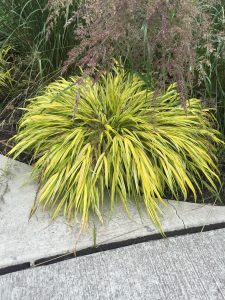
Sources of information:
http://www.missouribotanicalgarden.org/PlantFinder/PlantFinderDetails.aspx?kempercode=b168
12. Nepeta x faassenii (3-17)
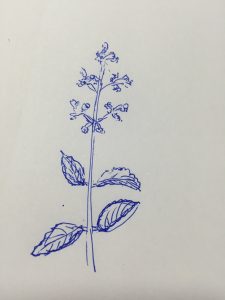
Scientific name: Nepeta x faassenii
Common name: Faassenn’s catmint
Family name: Lamiaceae
Type:Herbaceous perennial
USDA hardiness zone: 3-8
Form: Spreading clumps; height: 30-50cm
Leaf: Soft, toothed, silver-green leaves; opposite
Flower: Lavender-blue flowers, highly aromatic; bloom in late spring and early summer.
Ecological characteristics/requirements:
- Easily grown in average, dry to medium, well-drained soils in full sun to part shade.
- Prefers cool, moist soils. Tolerate summer drought.
- Shear flower spikes after initial flowering to promote continued bloom. Plants may be cut back before first flowering to promote more compact size.
Suitable uses: Rock gardens, border fronts, cottage gardens or herb gardens. Also a good plant for edging or small scale ground cover. Containers.
Quick ID: Typical mint smell of lavender-blue flowers
Photographs:


(From: http://www.perryhillnurseries.co.uk/catalogue/perennials/nepeta/)
Sources of information:
http://www.missouribotanicalgarden.org/PlantFinder/PlantFinderDetails.aspx?kempercode=e330
13. Allium christophii (4-2)

Scientific name: Allium christophii
Common name: star of Persia
Family name: Amaryllidaceae
Type:bulb
USDA hardiness zone: 4-8
Form: dense, clumping; height: 30-60cm
Leaf: Strap-shaped, gray-green, basal leaves form a clump of foliage in spring
Flower: Spring bloom of large, spherical, pale lavender flowerheads. Each flowerhead is packed with up to 100 individual flowers.
Ecological characteristics/requirements:
– Easily grown in rich, dry to medium moisture, well-drained loams in full sun.
– Performs best in dry, sunny areas.
– Established plantings have good drought tolerance.
– Deadhead flowers before seed sets to help control any unwanted spreading.
Suitable uses: Rock gardens, beds and borders, cottage gardens and meadows. Containers. Cut flowers
Quick ID: Large, spherical, pale lavender flowerheads, individual flowers are star-shaped
Photographs:
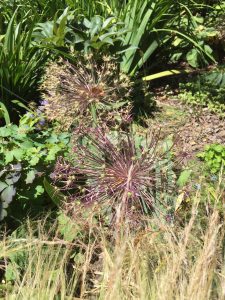
Sources of information:
http://www.missouribotanicalgarden.org/PlantFinder/PlantFinderDetails.aspx?kempercode=d499
14. Campanula persicifolia (4-4)
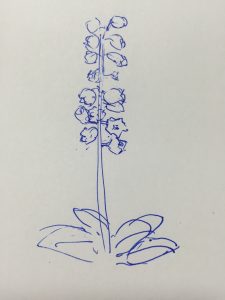
Scientific name: Campanula persicifolia
Common name: chimney bellflower
Family name: Campanulaceae
Type:Herbaceous perennial
USDA hardiness zone: 3-7
Form: Upright; height: 0.6-1m
Leaf: Rosettes of narrow, toothed, leathery, bright green leaves
Flower: Large, outward facing, purple-blue, broad bell-shaped flowers in slender, terminal racemes atop erect, unbranched, nearly leafless stems, in late spring to early summer.
Ecological characteristics/requirements:
– Easily grown in average, well-drained soils in full sun to part shade.
– Plants prefer cool summer climates; intolerant of the extreme heat; appreciate some part afternoon shade in hot summer climates.
– Needs regular and even moisture.
– plants will spread both by self-seeding and offsets, easy to escape from gardens. Deadhead spent flowers to encourage additional bloom and curb any unwanted self-seeding.
Suitable uses: Borders. Cottage gardens. Also effective in lightly shaded woodland areas where plants can be left alone to naturalise. Mass or large groups are best.
Quick ID: Terminal racemes of outward facing, purple-blue, broad bell-shaped flowers
Photographs:
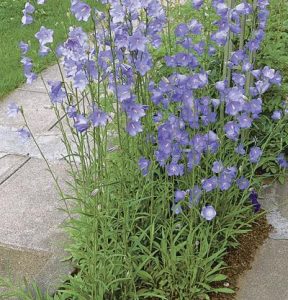
(From: http://www.finegardening.com/peach-leaved-bellflower-campanula-persicifolia)
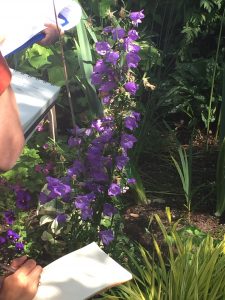
Sources of information:
15. Goniolimon tataricum (4-12)

Scientific name: Goniolimon tataricum
Common name: German statice
Family name: Plumbaginaceae
Type:Herbaceous perennial
USDA hardiness zone: 4-10
Form: clumping; height: 30-50cm
Leaf: smooth, pale green leaves
Flower: airy, branched, spreading panicles of tiny, soft, tubular flowers with white to light blue outer sepals and tiny rose-pink inner petals in summer. Dry flowers still keep its color.
Ecological characteristics/requirements:
- Best grown in sandy, dry to medium, well-drained soils in full sun
- Drought tolerant; salt tolerant
- Prefers some part afternoon shade in hot climates.
- Propagate by division or root cuttings or seed.
Suitable uses: Borders, cut flowers and dried bouquets. Performs well in seaside gardens due to salt tolerance.
Quick ID: Airy, branched, spreading panicles of tiny, soft, wild flowers
Photographs:

Sources of information:
http://www.missouribotanicalgarden.org/PlantFinder/PlantFinderDetails.aspx?kempercode=c473
16. Tanacetum parthenium ‘Aureum’ (4-20)
Scientific name: Tanacetum parthenium ‘Aureum’
Common name: golden feverfew
Family name: Asteraceae
Type:Herbaceous perennial
USDA hardiness zone: 5-8
Form: mounded, clumping; height: 20-30cm
Leaf: Pinnately lobed leaves are deeply cut nearly to the midrib, toothed and slightly hairy below; strongly scented
Flower: Daisy-like flowers with white petals and button-like yellow center disks,arranged in dense corymbs, bloom for a long summer.
Ecological characteristics/requirements:
- full sun
- Prefers moist, humusy soils with good drainage. Drought tolerant but soils must not be allowed to dry out.
- Self-seeding can be quite aggressive in optimum growing conditions. Shear off spent flowers immediately after bloom in order to control unwanted self-seeding.
Suitable uses: Edger or bedding plant. Better be used in naturalised areas or cottage gardens where it can be allowed to freely self-seed.
Quick ID: Small daisy-like flowers and aromatic foliage which emerges yellow in spring but turns mostly green by mid-summer.
Photographs:
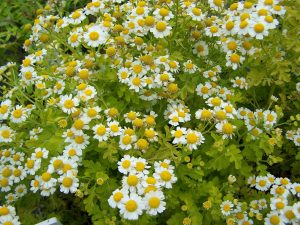
(From: http://www.perryhillnurseries.co.uk/catalogue/perennials/tanacetum/)
Sources of information:
http://www.missouribotanicalgarden.org/PlantFinder/PlantFinderDetails.aspx?kempercode=z9607
17. Allium cernuum(N) (5-2)
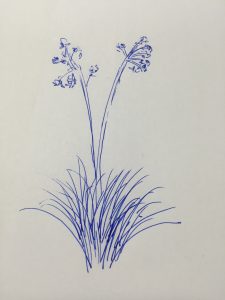
Scientific name: Allium cernuum
Common name: nodding onion
Family name: Amaryllidaceae
Type:bulb
USDA hardiness zone: 4-8
Form: clumping; height: 30-50cm
Leaf: Clumps of flat, narrow, grass-like leaves
Flower: Tiny bell-shaped, light pink flowers in clusters atop erect. summer flowers at least bloom for a month
Ecological characteristics/requirements:
– Easily grown in dry to medium moisture, well-drained soil in full sun to light shade. Best in full sun, but appreciates some light afternoon shade in hot summer climates.
– Plants will naturalise by self-seeding and bulb offsets in optimum growing conditions. Deadhead flowers before seed sets to help control any unwanted spread.
Suitable uses: Rock gardens, border fronts, cottage gardens or naturalised areas.
Quick ID: Flat, narrow, grass-like leaves; tiny, bell-shaped, pink flowers
Photographs:

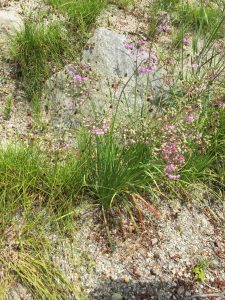
Sources of information:
http://www.missouribotanicalgarden.org/PlantFinder/PlantFinderDetails.aspx?kempercode=z580
18. Calendula officinalis (5-6)

Scientific name: Calendula officinalis
Common name: pot marigold
Family name: Asteraceae
Type:annual
USDA hardiness zone: 2-11
Form: clumping; height: 30-50cm
Leaf: Aromatic, smooth green leaves
Flower: Bright orange, single to double flowerheads with contrasting darker center disks; in cool climates appear over a long summer to fall bloom period; can be eaten as salad
Ecological characteristics/requirements:
– Likes fertile, well-drained soils in full sun; generally appreciate some part afternoon shade in hot summer climates but become leggy of in too much shade.
– Deadhead spent flowers to promote additional bloom.
– Attracts butterflies
Suitable uses: Beds, borders, cottage gardens, cutting gardens or pots/containers.
Quick ID: Distinct smell; daisy-like bright yellow to deep orange flowers
Photographs:


Sources of information:
http://www.missouribotanicalgarden.org/PlantFinder/PlantFinderDetails.aspx?kempercode=a566
19. Delosperma cooperi (5-8)
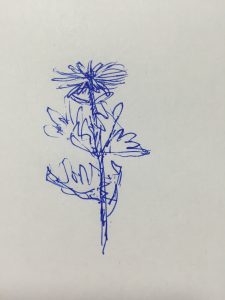
Scientific name: Delosperma cooperi
Common name: hardy ice-plant
Family name: Aizoaceae
Type:Herbaceous perennial
USDA hardiness zone: 6-10
Form: succulent, spreading, evergreen groundcover; height: 10-15cm
Leaf: Succulent, fleshy, cylindrical, green leaves.
Flower: Daisy-like, bright red-purple flowers cover the plant from June to September.
Ecological characteristics/requirements:
– Native to South Africa
– Best grown in dry, sharply-drained soils in full sun.
– Good tolerance for heat and drought, but intolerant of shade
Suitable uses: Groundcover or edger in sunny areas of desert gardens, rock gardens, border fronts or slopes. Excellent green roof plant.
Quick ID: Daisy-like, bright red-purple flowers on succulent foliage
Photographs:
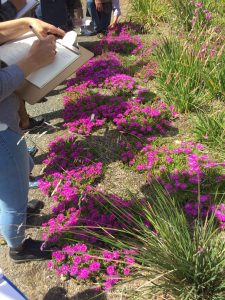

Sources of information:
http://www.missouribotanicalgarden.org/PlantFinder/PlantFinderDetails.aspx?kempercode=b464
20. Eschscholzia californica (5-10)
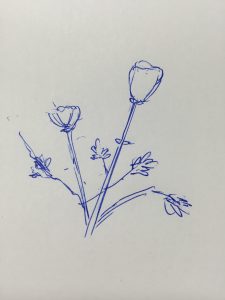
Scientific name: Eschscholzia californica
Common name: California poppy
Family name: Papaveraceae
Type:Herbaceous perennial
USDA hardiness zone: 6-10
Form: loose, free-branching mounds; height: 30-50cm
Leaf: Finely divided, fern-liked, blue-green leaves
Flower: Single, cup-shaped, 4-petal, silky flowers in typically bright orange, blooming on long stems from late spring to early summer. Flowers close up in rainy or cloudy weather and at night.
Ecological characteristics/requirements:
- Easily grown in sandy, poor to average, well-drained soils in full sun. Not good in rich soil. Sharp soil drainage is essential.D
- Drought tolerant, doesn’t like shade, competitions.C
- Can survive in winter if not too cold
- Deadhead flowers regularly to promote additional bloom.
- Invasive in Victoria
Suitable uses: Beds, border fronts, rock gardens, along paths or walkways, or containers. Good selection for large naturalised plantings in locations where plants freely reseed.
Quick ID: Bright orange silky flowers; pink calixs on stem
Photographs:

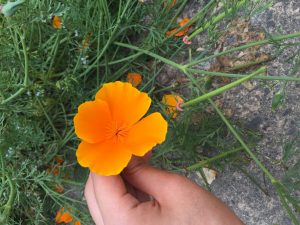
Sources of information:
http://www.missouribotanicalgarden.org/PlantFinder/PlantFinderDetails.aspx?kempercode=b753
21. Adiantum venustum (6-2)
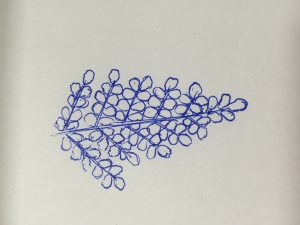
Scientific name: Adiantum venustum
Common name: Himalayan maidenhair
Family name: Pteridaceae
Type:fern
USDA hardiness zone: 5-9
Form: low, delicate, spreading patch; height: 20-30cm
Leaf: Glossy, small leaves of light green, tri-pinnately compound
Flower: No flower
Ecological characteristics/requirements:
– Prefers a rich, well-drained soil that stays evenly moist.
– Cannot tolerate sun for more than 1 hour
– Big dogs may break the plant
Suitable uses: A beautiful edging or ground cover plant. Also great in pots.
Quick ID: Black stems holding small, soft green leaves
Photographs:
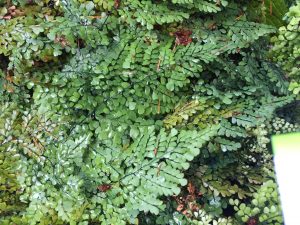

Sources of information:
http://www.perennials.com/plants/adiantum-venustum.html
22. Begonia grandis (6-6)

Scientific name: Begonia grandis
Common name: hardy begonia
Family name: Begoniaceae
Type:herbaceous perennial
USDA hardiness zone: 6-7
Form: bushy mound; height: 40-60cm
Leaf: Big leaves with cordate bases; olive green above and reddish green with red veining beneath.
Flower: Monoecious, male and female pale pink flowers bloom in pendent clusters, from July to early fall.
Ecological characteristics/requirements:
– Native to China
– Best grown in moist, organically rich, well-drained soils. Soils should not be allowed to dry out.
– shade loving
– Heavy winter mulch is advisable in the St. Louis area where plants are not reliably winter hardy.
Suitable uses: Good late summer flowering plant which mixes well with hostas and ferns in the shade garden, woodland garden or shaded border.
Quick ID: Red beneath foliage
Photographs:

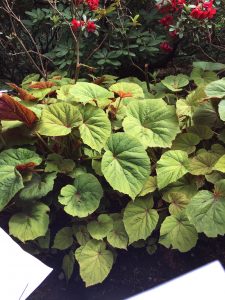
Sources of information:
http://www.missouribotanicalgarden.org/PlantFinder/PlantFinderDetails.aspx?kempercode=c843
23. Deschampsia cespitosa (6-13)
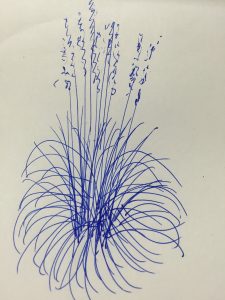
Scientific name: Deschampsia cespitosa
Common name: tufted hair grass
Family name: Poaceae
Type:Ornamental grass
USDA hardiness zone: 4-9
Form: clumping; height: 0.5-1m
Leaf: Dense tussock of thin, flat, arching dark green grass blades; Semi-evergreen
Flower: wide, airy panicles of tiny flowers (tones of gold, silver, purple and green) on protruding flower stems which form a delicate cloud of subtle colors over the foliage in summer. Flower panicles turn yellowish-tan after bloom and may remain attractive through much of the winter.
Ecological characteristics/requirements:
– Easily grown in average, well-drained soils. Prefers moist, organically rich soils.
– Grows well in moderately shady locations, however it will not flower well if in too much shade.
Suitable uses: Excellent massed in woodland gardens or naturalized areas. Also effective as a specimen or in groups in shaded areas of borders, large rock gardens or moist areas along ponds or streams. Mixes well with shade loving perennials such as ferns and hostas.
Quick ID: cloud of subtle flowers over dark green foliage
Photographs:
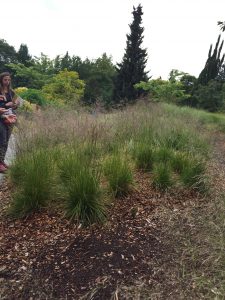
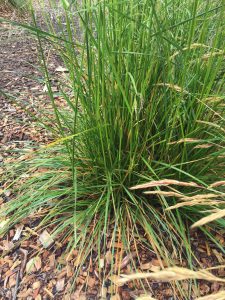
Sources of information:
http://www.missouribotanicalgarden.org/PlantFinder/PlantFinderDetails.aspx?kempercode=c450
24. Ophiopogon planiscapus ‘Nigrescens’ (6-19)
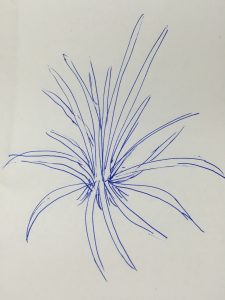
Scientific name: Ophiopogon planiscapus ‘Nigrescens’
Common name: black mondo grass
Family name: Asparagaceae
Type:herbaceous perennial
USDA hardiness zone: 6-9
Form: stiff, clumping; height: 20-30cm
Leaf: Narrow, linear, grass-like leaves in very dark purple and in many light situations appears black.
Flower: Racemes of bell-shaped, light pink flowers appear on dark stems in summer, providing excellent contrast with the dark leaves; followed by glossy dark purple berries.
Ecological characteristics/requirements:
– Best grown in rich, humusy, well-drained soils in full sun to part shade.
– Prefers consistent moisture in soils which do not dry out.
– shade tolerant
Suitable uses: Border foregrounds, rock gardens. Be used as specimen, group, small area ground cover or path edger.
Quick ID: Purplish-black leaves; bell-shaped pink flowers; globular bluish-black berries
Photographs:
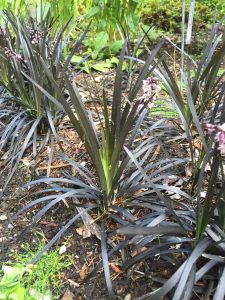
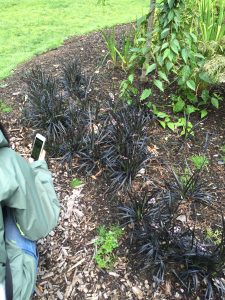
Sources of information:
http://www.missouribotanicalgarden.org/PlantFinder/PlantFinderDetails.aspx?kempercode=e400
25. Athyrium filix-femina (7-2)
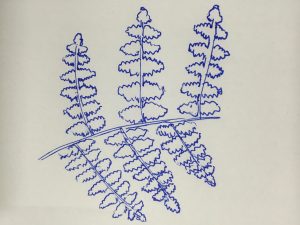
Scientific name: Athyrium filix-femina
Common name: lady fern
Family name: Athyriaceae
Type:deciduous fern
USDA hardiness zone: 4-8
Form: clumping; height: 0.8-1.2m
Leaf: Diamond-shaped in outline; 2 times pinnate: 20 – 30 leaflet pairs, alternate, toothed or divided
Flower: No flower
Ecological characteristics/requirements:
- Found in moist to wet forested thickets and along streambanks
- Easy to grow in a moist, partially shaded site
- Crisp, easy to break
Suitable uses: Good filler in the shady to part sun garden or natural wooded area.
Quick ID: fresh-green, lacy, bi-pinnate, lance-shaped fronds; the segments with toothed margins.
Photographs:


Sources of information:
http://www.borealforest.org/ferns/fern1.htm
http://www.gardeningknowhow.com/ornamental/foliage/lady-fern/planting-lady-ferns.htm
26. Echinacea purpurea (7-5)
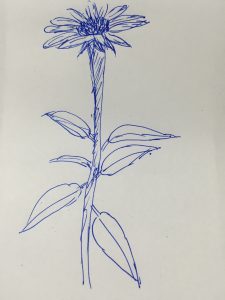
Scientific name: Echinacea purpurea
Common name: purple coneflower
Family name: Asteraceae
Type:herbaceous perennial
USDA hardiness zone: 3-8
Form: erect, rough-hairy; height: 0.5-1m
Leaf: Coarse, hairy; alternate
Flower: Daisy-like, purple coneflowers bloom throughout the summer atop stiff stems.
Ecological characteristics/requirements:
– Very tough plant, tolerate Deer, Drought, Clay Soil, Dry Soil, Shallow-Rocky Soil
– Suitable for hot, dry location
– Cannot tolerate shade, access moisture
– Plants usually rebloom without deadheading, however prompt removal of spent flowers improves general appearance.
Suitable uses: Excellent, long-blooming flower for massing in the border, meadow, naturalised area, wildflower garden or part shade area of woodland garden.
Quick ID: Daisy-like, purple coneflowers
Photographs:
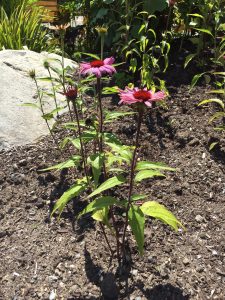
Sources of information:
http://www.missouribotanicalgarden.org/PlantFinder/PlantFinderDetails.aspx?kempercode=c580
27. Kirengeshoma palmata (7-11)

Scientific name: Kirengeshoma palmata
Common name: yellow wax bells
Family name: Hydrangeaceae
Type:herbaceous perennial
USDA hardiness zone: 5-8
Form: shrubby; with strong lines; height: 1.5-2m
Leaf: Opposite; coarsely toothed, deeply lobed, maple-like leaves
Flower: Drooping, waxy, bell-shaped yellow flowers appear in both terminal and upper leaf axillary clusters, from late summer to early autumn.
Ecological characteristics/requirements:
– Native to Korea,Japan
– Best grown in moist, acidic, humusy, well-drained soils in part shade to full shade.
– Shade loving
Suitable uses: Unique and interesting plant for the shaded borders or woodland gardens.
Quick ID: Purplish stems kind of sticky; coarsely toothed, deeply lobed, maple-like leaves; waxy, bell-shaped flowers
Photographs:
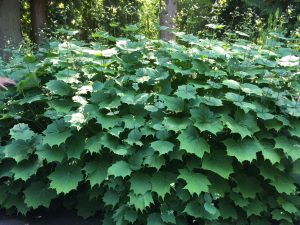
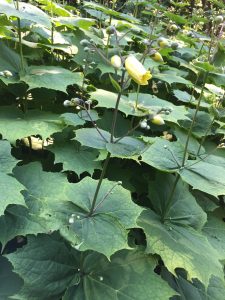
Sources of information:
28. Thalictrum rochebruneanum (7-22)
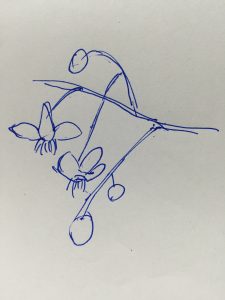
Scientific name: Thalictrum rochebruneanum
Common name: lavender mist meadow rue
Family name: Ranunculaceae
Type:herbaceous perennial
USDA hardiness zone: 4-7
Form: slender, clumping; height: 1.5-2m
Leaf: 4 times pinnate; fine-textured, blue-green
Flower: Lavender-purple flowers with contrasting yellow stamens; no petals just sepals; pendulous in loose, airy clusters, appear in late summer.
Ecological characteristics/requirements:
– Prefers a rich, humusy, moist soil and shady, light, dappled sun.
– Intolerant of the hot and humid summers
– Prone to incline when grows tall, needs structure to support
– Tolerate rabbits, deers
Suitable uses: Good shade provider with excellent foliage and late summer bloom to the perennial border, wildflower garden, meadow or naturalised area. Good background plant in group.
Quick ID: Bluish-green leaves, 4 times pinnately compound; lavender-purple flowers in moist-like clusters
Photographs:

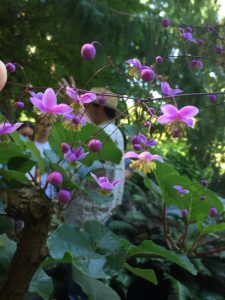

Sources of information:
http://www.missouribotanicalgarden.org/PlantFinder/PlantFinderDetails.aspx?kempercode=i920
29. Sagittaria latifolia (8-3)

Scientific name: Sagittaria latifolia
Common name: broadleaf arrowhead
Family name: Alismataceae
Type:herbaceous perennial
USDA hardiness zone: 5-10
Form: arrow-liked, vigorous; height: 20-30cm
Leaf: Arrowhead-shaped, deciduous
Flower: White flowers in whorls of three petals
Ecological characteristics/requirements:
– Needs full sun for best flowering
– Plants will naturalize by rhizomes and self-seeding.
– It commonly grows submerged in shallow water or out of water on wet muddy banks.
Suitable uses: Marginal aquatic perennial for Naturalised Gardens, Rain Garden, Bog Garden.
Quick ID: Arrowhead-shaped leaves
Photographs:
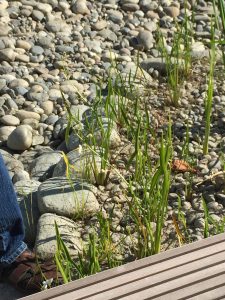
Sources of information:
http://www.missouribotanicalgarden.org/PlantFinder/PlantFinderDetails.aspx?kempercode=a633
30. Chamerion angustifolium (8-6)
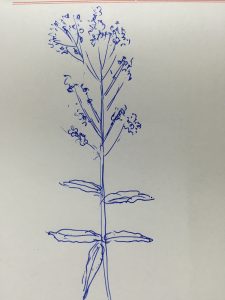
Scientific name: Chamerion angustifolium
Common name: fireweed
Family name: Onagraceae
Type:herbaceous perennial
USDA hardiness zone: 3-7
Form: tall, dense; height: 1-2m
Leaf: Alternate; long, narrow; white central vein on most leaves; can make tea
Flower: Terminal raceme of many showy purple flowers, each flower has four petals alternate with four narrow sepals.
Ecological characteristics/requirements:
– Very hardy, don’t like shade
– Attracts the bees and hummingbirds
– Seed itself easily where it’s open and sunny, spreads through wind
– Able to suddenly appear after a wildfire.
Suitable uses: Attractive flowered plant for open meadows, along streams, roadsides, and forest edges.
Quick ID: Terminal raceme of many purple flowers, showy stunning.
Photographs:

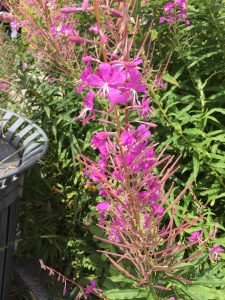
Sources of information:
http://www.ediblewildfood.com/fireweed.aspx
31. Equisetum hyemale (8-8)
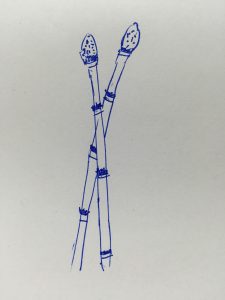
Scientific name: Equisetum hyemale
Common name: scouring rush
Family name: Equisetaceae
Type:herbaceous perennial
USDA hardiness zone: 3-11
Form: erect, reed-like; height: 30-50cm
Stem: Evergreen, cylindrical, jointed, hollow, usually unbranched, rough
Leaf: Tiny leaves are joined together around the stem, forming a narrow black-brown band or ring sheath at each joint.
Flower: No flowers
Ecological characteristics/requirements:
– Full sun, wet to moist conditions
– Tolerate drought, shade, sun; very aggressively, especially in locations where the soil is poorly drained.
– It has few problems with pests and disease organisms.
– Need maintenances to keep it clean
– Dragonfly perches
Suitable uses: Striking in a container, pond or landscape setting(open wooded areas, roadside ditches, pastures, and gravelly railroad embankments in black soil prairies and sand prairies). It is best to contain it in a pot with no holes and be watchful that it doesn’t creep over the edge. Often grown in Japanese-style gardens, at the edge of ponds and in the margins of ornamental water garden.
Quick ID: Great texture of green stems with black-brown rings at each joint.
Photographs:
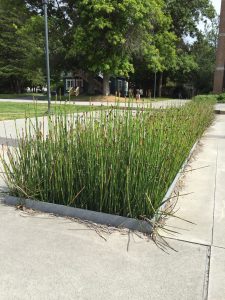
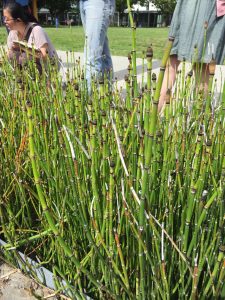
Sources of information:
http://www.illinoiswildflowers.info/grasses/plants/scouring_rush.htm
32. Thymus serpyllum (8-20)

Scientific name: Thymus serpyllum
Common name: mother-of-thyme / wild thyme
Family name: Lamiaceae
Type:herbaceous perennial
USDA hardiness zone: 4-8
Form: hairy, prostrate, creeping, woody-based; height: 2-5cm
Leaf: Tiny, opposite, almost sessile, glossy blue-green leaves; mint aromatic
Flower: Dense of tiny, tubular, bell-shaped, pink to purple flowers appear in summer on erect flowering stems; attractive to bees.
Ecological characteristics/requirements:
– Full sun
– Best grown in loose, sandy, gritty or rocky, nutrient-poor soils with sharp drainage. Dislikes moist to wet soils where rot may develop.
– Drought tolerant
– Cut back stems as necessary to maintain plant appearance,
Useful Cultivators and Selections:
Numerous cultivars of this species have been described, featuring plants of varying sizes (creeping to upright), varying flower colors (white, pink, red or purple), and varying foliage colors (dark green to gold to variegated).
Suitable uses: Best as a small area ground cover or filler between stepping stones, edge slopes. Effective for sunny areas of borders, patios and along paths.
Quick ID: Lovely flat foliage mat with dense pink to purple flowers.
Photographs:

Sources of information:
http://www.missouribotanicalgarden.org/PlantFinder/PlantFinderDetails.aspx?kempercode=a294
33. Agastache foeniculum (9-1)
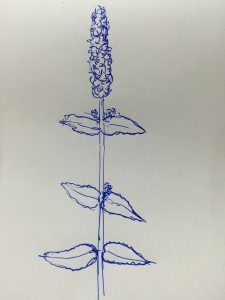
Scientific name: Agastache foeniculum
Common name: anise hyssop
Family name: Lamiaceae
Type:herbaceous perennial
USDA hardiness zone: 4-8
Form: upright clumping, nice and neat; height: 1-1.5m
Leaf: Green leaves with toothed margins; opposite; anise-scented
Flower: Mid to late summer bloom (3-5weeks) of small, fuzzy, lavender to purple flowers in terminal spikes
Ecological characteristics:
– Needs well-drained soils, prefers moist site
– Best in full sun
– Well-behaved in Vancouver
– Versatile plant: flowers are attractive to bees (good nectar plant), hummingbirds and butterflies; Aromatic leaves can be used to make herbal teas or jellies. Seeds can be added to cookies or muffins. Dried leaves can be added to potpourris.
Suitable uses: Borders, wildflower gardens, herb gardens, butterfly gardens or meadows.
Quick ID: Lavender to purple flowers in terminal spikes; anise-scented foliage
Photographs:


Sources of information:
http://www.missouribotanicalgarden.org/PlantFinder/PlantFinderDetails.aspx?kempercode=d554
34. Echium vulgare (9-9)
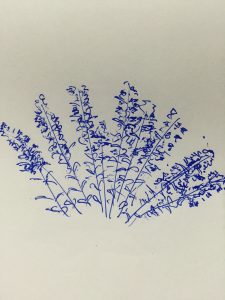
Scientific name: Echium vulgare
Common name: viper’s bugloss
Family name: Boraginaceae
Type:herbaceous, Biennial or cool weather annual
USDA hardiness zone: 4-8
Form: clumping; height: 0.4-0.8m
Leaf: Lance-shaped, rough
Flower: Funnel-shaped blue flowers with protruding red stamens, dense flowering. bloom from late May to September
Ecological characteristics/requirements:
– Full sun
– Grown in dry to medium moisture, well-drained soils
– Tolerate poor soils
– Freely self-seed in the landscape, sometimes aggressively. Remove flowering spikes before nutlets mature to limit unwanted self-seeding.
Suitable uses: Sunny borders, cottage gardens, wild gardens and naturalized areas
Quick ID: Bristly hairs on the leaves and stems; pink buds turn to blue flowers
Photographs:


Sources of information:
35. Erigeron karvinskianus (9-10)
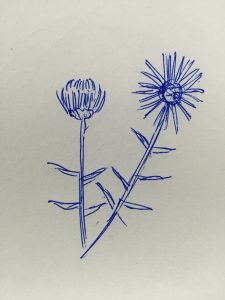
Scientific name: Erigeron karvinskianus
Common name: Mexican daisy
Family name: Asteraceae
Type:herbaceous perennial
USDA hardiness zone: 8-9
Form: spreading; height: 15-20cm
Leaf: Narrow, hairy
Flower: Masses of daisy-like flower-heads with yellow centres, opening white but soon turning pinkish-purple, gives it two-tone effect.
Ecological characteristics/requirements:
– Full sun
– Grows in fertile, well-drained soil that does not dry out in summer
– Deadhead to encourage further flowering
Suitable uses: Rock gardens; sunny beds or borders; cut flower. Superb in containers or window boxes and on rock walls.
Quick ID: Masses of small daisy-liked flowers in white and pink.
Photographs:

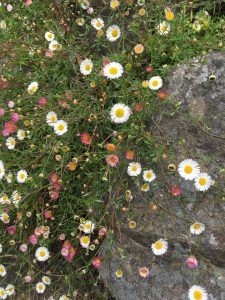
Sources of information:
http://www.finegardening.com/fleabane-erigeron-karvinskianus
36. Oenothera biennis (9-17)

Scientific name: Oenothera biennis
Common name: evening primrose
Family name: Onagraceae
Type:herbaceous biennial
USDA hardiness zone: 4-8
Form: clumping; height: 1-1.5m
Leaf: Basal rosette of oblong leaves; the upper on the stem, the smaller the leaves
Flower: Long, leafy racemes of big bowl-shaped, fragrant, yellow flowers which open in the evening in summer and autumn
Ecological characteristics/requirements:
- Does best in well-drained soils in full sun
- Drought tolerant
- Attractes wildlife
- Edible
Suitable uses: Dry open fields, roadsides, railway banks, waste areas and in open woods. Meadow or Cultivated Beds.
Quick ID: At the top of a leafy stalk bloom lemon-scented, large yellow flowers
Photographs:
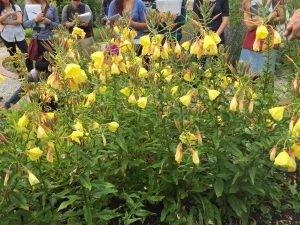
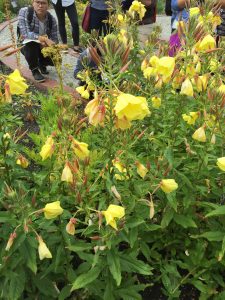
Sources of information:
http://www.pfaf.org/user/Plant.aspx?LatinName=Oenothera+biennis
https://plants.usda.gov/plantguide/pdf/cs_oebi.pdf
37. Allium giganteum (10-1)

Scientific name: Allium giganteum
Common name: giant purple allium / giant onion
Family name: Amaryllidaceae
Type:bulbous perennial
USDA hardiness zone: 5-8
Form: standing; height: 1-1.5m
Leaf: Basal rosette of greyish-green, strap-shaped leaves. Leaves begin to die back as plants begin flowering.
Flower: Dense, globular cluster of tiny, star-shaped lilac-purple florets
Ecological characteristics/requirements:
– Full sun
– Well-drained soil
– Best sited in locations sheltered from strong winds
Suitable uses: Dramatic border background plant which is best sited in groups of at least 5-7 bulbs.
Quick ID: Thick, naked, tall stem, topped by a dense purple ball-flowerhead.
Photographs:
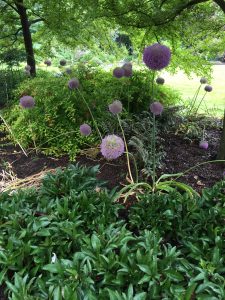
Sources of information:
http://www.missouribotanicalgarden.org/PlantFinder/PlantFinderDetails.aspx?kempercode=j250
38. Crocosmia ‘Lucifer’ (10-3)

Scientific name: Crocosmia ‘Lucifer’
Common name: Lucifer montbretia
Family name: Iridaceae
Type:bulbous perennial
USDA hardiness zone: 5-9
Form: clumping; height: 1-1.5m
Leaf: Broad, sword-like green leaves, good texture, gracefully arched
Flower: Tubular, nodding, scarlet red, one-sided flowers borne along the upper portions of arching
Ecological characteristics/requirements:
– Prefers full sun, but appreciates part shade in hot summer climates
– Not reliably winter hardy in USDA Zone 5 where it needs a protected location and winter mulch.
Suitable uses: Adds a tropical flair to gardens; adds a spiky textured element to the landscape. Best when planted in clumps of 12 or more. Provides contrast to the perennial border. Broad, sword-like leaves make it attractive even without flowers.
Quick ID: One-sided flame blooms
Photographs:


Sources of information:
http://www.missouribotanicalgarden.org/PlantFinder/PlantFinderDetails.aspx?kempercode=h680
39. Dryopteris erythrosora (10-8)
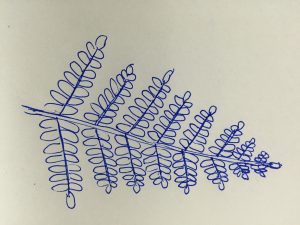
Scientific name: Dryopteris erythrosora
Common name: autumn fern
Family name: Dryopteridaceae
Type:evergreen fern
USDA hardiness zone: 5-8
Form: arching, vase-shaped clump; height: 20-40cm
Leaf: Triangular, bi-pinnate fronds with red sori. New fronds unfurl in striking shades of orange-red to copper-pink before eventually maturing to glossy deep green by summer.
Flower: Non-flowering
Ecological characteristics/requirements:
– Prefers consistently moist, humusy soils. Soils must not be allowed to dry out.
– Better sites in locations sheltered from strong winds to protect the fronds.
– Plants slowly spread over time by short creeping rhizomes.
– Tolerate heavy shade, rabbits
Suitable uses: Used in moist or shade sites. May be massed in woodland areas as a ground cover.
Quick ID: Triangular, bi-pinnate fronds; Back of fronds are red
Photographs:
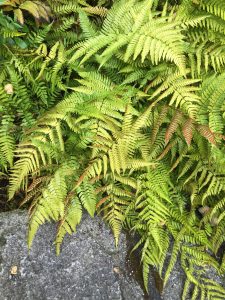
Sources of information:
http://www.missouribotanicalgarden.org/PlantFinder/PlantFinderDetails.aspx?kempercode=h750
40. Olearia × haastii (10-14)
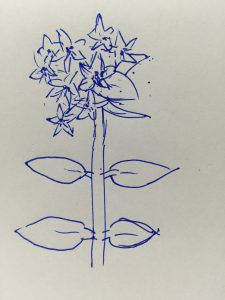
Scientific name: Olearia × haastii
Common name: daisy bush
Family name: Asteraceae
Type:evergreen shrub
USDA hardiness zone: 8-10
Form: dense, bushy; height: 1-2m
Leaf: Smooth, oval green leaves, glaucous and glossy.
Flower: Dense sprays of star-shaped, white flowers with yellow centres, appear in mid-to-late summer.
Ecological characteristics/requirements:
– Needs fertile, well-drained soil
– Stands up well to strong winds and salt-laden air
Suitable uses: Good summer display. Hedging or windbreaks in coastal gardens or landscapes.
Quick ID: Clusters of white, daisy-like flowers; sticky stems
Photographs:

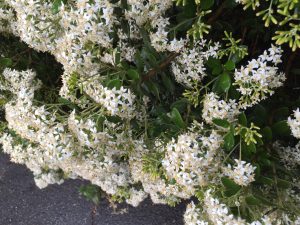
Sources of information:
http://www.crocus.co.uk/plants/_/olearia–haastii/classid.4170/
41. Bidens aurea (11-5)
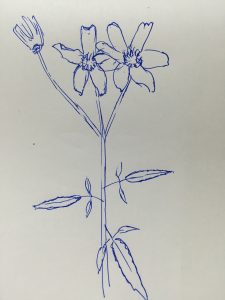
Scientific name: Bidens aurea
Common name: Arizona beggarticks
Family name: Asteraceae
Type:herbaceous perennial
USDA hardiness zone: 5-8
Form: bushy; height: 1-1.5m
Leaf: Finely dissected pinnate leaves, thin
Flower: White flowers with yellow rays and darker yellow centers atop erect stems, flowering over 4 months
Ecological characteristics/requirements:
– Well-drained soil in full sun
– Drought tolerant
– Very aggressing, no weeds can get in
Suitable uses: Borders, wild or naturalized areas
Quick ID: Vigorous standing white daisy-like flowers with yellow rays and darker yellow centers
Photographs:

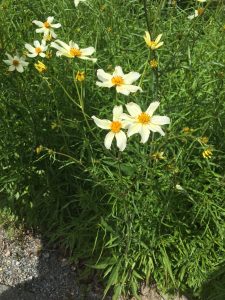
Sources of information:
http://www.missouribotanicalgarden.org/PlantFinder/PlantFinderDetails.aspx?kempercode=y180
42. Filipendula palmata (11-7)
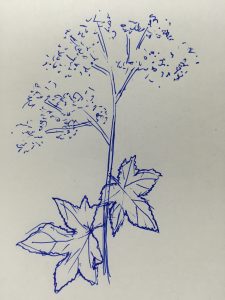
Scientific name: Filipendula palmata
Common name: Siberian meadowsweet
Family name: Rosaceae
Type:herbaceous perennial
USDA hardiness zone: 3-8
Form: spreading; height: 1-1.5m
Leaf: Palmate
Flower: Tiny pink flowers in upright panicles, like fleece
Ecological characteristics/requirements:
– Full sun to partial shade
– Highly adaptable. Soils must be moist all summer to keep meadowsweet looking its best.
– Cut back after flowering to the ground and it will resprout when the conditions are right.
Useful Cultivators and Selections:
Filipendula palmata ‘Elegans’: cream white flowers with red stamens; offers not only lovely summer flowers but also attractive foliage and habit throughout the growing season.
Suitable uses: Clumping plant for clay, pond margins or moist soils.
Quick ID: Attractive pink fluffy flowers; maple-like leaves
Photographs:
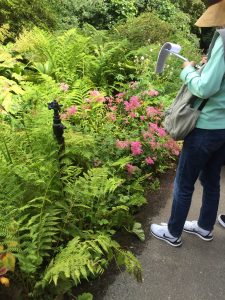
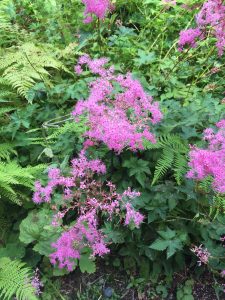
Sources of information:
https://plants.ces.ncsu.edu/plants/all/filipendula-palmata/
43. Helianthus annuus (11-10)
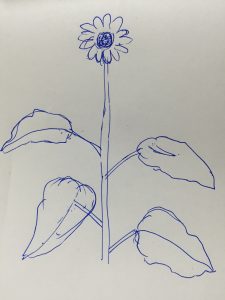
Scientific name: Helianthus annuus
Common name: annual sunflower
Family name: Asteraceae
Type:herbaceous annual
USDA hardiness zone: 2-11
Form: upright; height: 1-1.5m
Leaf: Big leaf, hairy, coarse; toothed margins; spirally-arranged
Flower: Sunflowers with orange-yellow rays and brown centre disks, last for long time.
Ecological characteristics/requirements:
– Fast growing
– Likes moist, well-drained soils in full sun, tolerates poor soils on the dry side
– Attracts Birds, Butterflies; produces pollens that very heathy for bees
Problems:
- Rust, leaf fungal spots and powdery mildew.
- Caterpillars and beetles often chew on the foliage.
- Larger varieties often need staking, particularly if grown in exposed locations.
Suitable uses: Specimen or mass. Borders, cottage gardens, bird gardens, wildflower gardens. Large varieties for border rears or backgrounds. Dwarf varieties for beds, border fronts or containers. Cutting flowers.
Quick ID: Sunflowers with orange-yellow rays and brown centre disks.
Photographs:
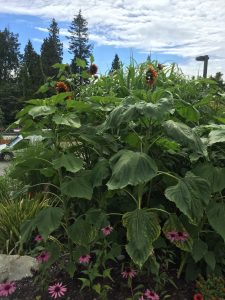
Sources of information:
http://www.missouribotanicalgarden.org/PlantFinder/PlantFinderDetails.aspx?kempercode=a583
44. Sedum ‘Herbstfreude’ (11-20)
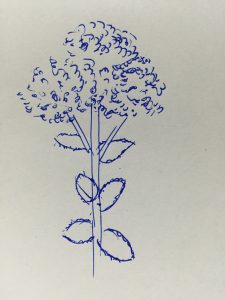
Scientific name: Sedum ‘Herbstfreude’
Common name: autumn joy sedum
Family name: Crassulaceae
Type:herbaceous perennial
USDA hardiness zone: 3-9
Form: clumping; height: 30-60cm
Leaf: Succulent, lettuce-green
Flower: Enormous dusty-pink flower heads in summer finally deepening to rich bronzy-red in fall to winter
Ecological characteristics/requirements:
– Full sun
– Hardy plant, tolerates drought, rock soil
– Well-drained, moderately fertile soil
– Attracts hummingbirds, butterflies
– Deer, rabbit tolerant
Suitable uses: 3 seasons of interests (summer, fall, winter) for gardens. Perfect filler plant for a sunny, well-drained spot.
Quick ID: Green broccoli-like buds; lovely lavender pink to red blooms.
Photographs:
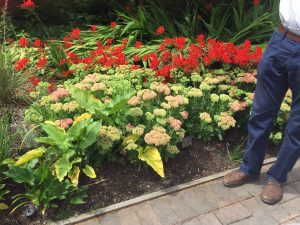
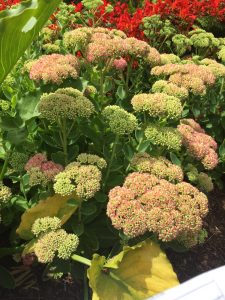
Sources of information:
https://www.gardenia.net/plant/sedum-herbstfreude-autumn-joy
45. Bergenia crassifolia (12-3)
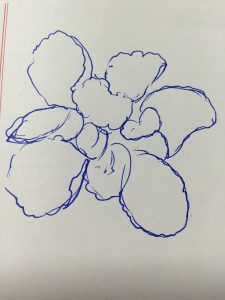
Scientific name: Bergenia crassifolia
Common name: pig squeak
Family name: Saxifragaceae
Type:Herbaceous perennial
USDA hardiness zone: 2-9
Form: spreading; height: 30-50cm
Leaf: Large, green, leathery glossy leaves with red margins
Flower: Lovely rose-pink flowers in clusters for mid-winter through early spring
Ecological characteristics/requirements:
– Long-lived
– Very hardy
– Prefers light shade in full sun, well-drained soil with little to moderate watering.
– Deer resistant
Suitable uses: Good ground cover even without flowers, can be planted in many different site: border, waterside, woodland, etc.
Quick ID: Thick spoon-shaped leaves, evergreen, some turn to red
Photographs:

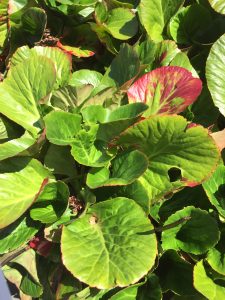
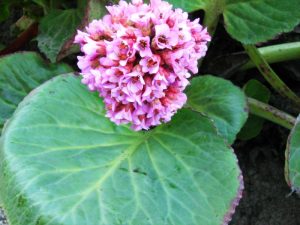
(From: https://commons.wikimedia.org/wiki/File:Bergenia_crassifolia.jpg)
Sources of information:
http://www.perennials.com/plants/bergenia-crassifolia.html
46. Iberis umbellata (12-13)
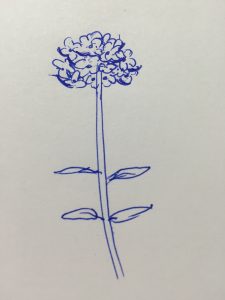
Scientific name: Iberis umbellata
Common name: globe candytuft
Family name: Brassicaceae
Type:Herbaceous annual
USDA hardiness zone: 3-8
Form: spreading; height: 30-45cm
Leaf: Linear, evergreen
Flower: Range in color from white, pink and mauve to purple, pretty and fragrant, blooming from early summer until frost.
Ecological characteristics/requirements:
– Attractive to bees, butterflies and birds
– Needs a sunny location, cannot grow in the shade
– Drought tolerant
– Better in well drained, well-composted, alkaline soil
Suitable uses: Striking flower color makes it a wonderful wildflower garden plant; can be taller groundcover in poor soil; also a good groundcover plant for gardening with kids; great cut flower.
Quick ID: Dense heads of tiny colorful flowers in summer
Photographs:


Sources of information:
http://www.plant-world-seeds.com/store/view_seed_item/3869
47. Liriope muscari (12-16)

Scientific name: Liriope muscari
Common name: lily turf
Family name: Asparagaceae
Type:herbaceous perennial
USDA hardiness zone: 5-10
Form: spreading; height: 30-50cm
Leaf: Evergreen, strap-liked, leaves with good texture
Flower: Showy bell-shaped flower in whorls on slender stalks, in late summer
Ecological characteristics/requirements:
– Prefers moist, well-drained, fertile soils in full sun to light shade
– Tolerate air pollution in urban areas
– Tolerates heat, humidity and drought
– Foraging wildlife that plagues gardens in rural areas
Suitable uses: Edging for walking paths or driveways or massed as a ground cover
Quick ID: Grape hyacinth-liked flower; strap-liked, arching, glossy leaves
Photographs:
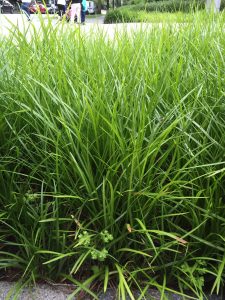
Sources of information:
http://www.missouribotanicalgarden.org/PlantFinder/PlantFinderDetails.aspx?kempercode=l100
48. Pontederia cordata (12-21)
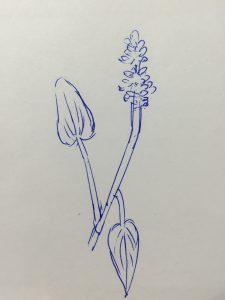
Scientific name: Pontederia cordata
Common name: pickerel weed
Family name: Pontederiaceae
Type:aquatic herbaceous perennial
USDA hardiness zone: 3-10
Form: standing; height: 15-30cm
Leaf: Deciduous; rounded cordate bases
Flower: Tiny, tubular soft blue flowers are densely packed into erect stem top, from June to October
Ecological characteristics/requirements:
– Needs full sun for best flowering
– Provides wildlife(Dragonflies and damselflies) standings and shelters for fishes.
– Better in containers; Outside of containers, rhizomes can spread rapidly to form colonies under optimum growing conditions
Suitable uses: Vigorous marginal aquatic perennial for water or bog gardens. Large containers or tubs.
Quick ID: Glossy, arrowhead-shaped green leaves; Dense, tubular blue flowers
Photographs:
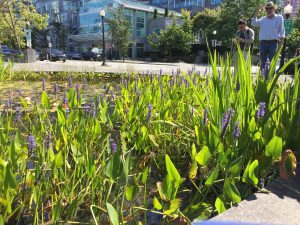

Sources of information:
http://www.missouribotanicalgarden.org/PlantFinder/PlantFinderDetails.aspx?kempercode=a428
49. Asclepias incarnata (13-3)
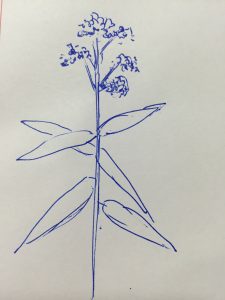
Scientific name: Asclepias incarnate
Common name: swamp milkweed
Family name: Apocynaceae
Type:Herbaceous perennial
USDA hardiness zone: 3-8
Form: upright. Height: 4-6 feet, Spacing: 2-3 feet
Leaf: Long, thin leaves, opposite arranged
Flower: Pink flowers at top umbrella-haped flowerheads, long summer bloom period
Ecological characteristics/requirements:
– Long-lived, slow-growing
– Require high moisture
– Need full sun or partial shade
– Tolerate heavy clay soils
– Deer-resistant
– Insect-pollinated
– Provide food for various butterflies and hummingbirds.
Suitable uses: It does well in moist soils and places near bodies of water. Wildflower useful for wetland rehabilitation. Good plant for wildlife mixture.
Quick ID: Tall plant with upright stems, opposite thin leaves; Lovely clusters of pink-purple flowers in umbrella shape.
Photographs:
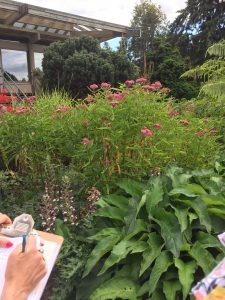

Sources of information:
https://plants.usda.gov/factsheet/pdf/fs_asin.pdf
50. Helianthemum nummularium (13-10)
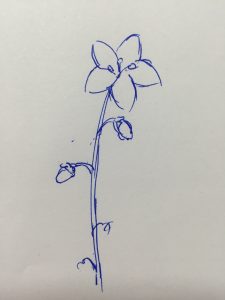
Scientific name: Helianthemum nummularium
Common name: sun rose / rock rose
Family name: Cistaceae
Type:Herbaceous perennial
USDA hardiness zone: 5-8
Form: low-growing, woody-stemmed, shrub-like; Height: 10-20cm
Leaf: Small, thin, evergreen
Flower: Range of Orange, pink, yellow or white wild flowers bloom for entire summer
Ecological characteristics/requirements:
– Prefers cool summers and warm winters, works well in Vancouver
– Requires excellent drainage, tolerates drought
– Need full sun, partial shade in hot summer
– Prefers sandy or rocky soil
Suitable uses: Groundcover, works best in rock gardens and well-drained borders. Sprawls exceedingly well over stone walls or dry slope. Naturalized landscape
Quick ID: Spreading masses with lovely, wild flowers and small gray-green leaves
Photographs:

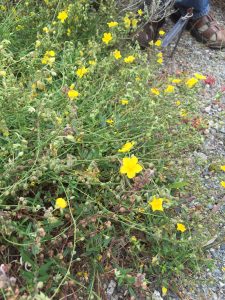
Sources of information:
http://www.gardening.cornell.edu/homegardening/scene72cf.html
51. Origanum ‘Barbara Tingey’ (13-18)
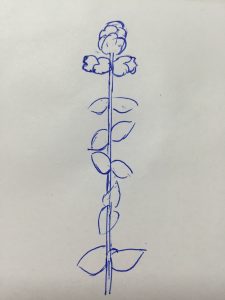
Scientific name: Origanum ‘Barbara Tingey’
Common name: round-leaved oregano
Family name: Lamiaceae
Type:Herbaceous perennial
USDA hardiness zone: 7-9
Form: spreading; Height: 10-20cm
Leaf: Semi-evergreen; opposite; rounded heart-shaped
Flower: Hop-like bracts that start out a light green and gain a pink-tinge as it grows, very decorative.
Ecological characteristics/requirements:
– Needs well drained soil in full sun, drought tolerant
– Bumblebees can nest in the ground area of this plant
– Deer resistant
Suitable uses: Groundcover; Rock Gardens; Container Plant
Quick ID: Plenty of light-green to pink bracts, like little pinecones; Blue-green, slightly rounded heart-shaped leaves.
Photographs:
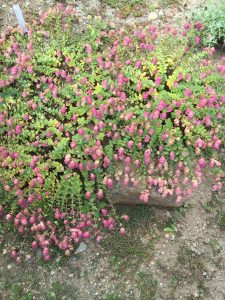

Sources of information:
http://www.rainyside.com/plant_gallery/herbs/OriganumBarbaraTingey.html
52. Rhodiola rosea (13-20)
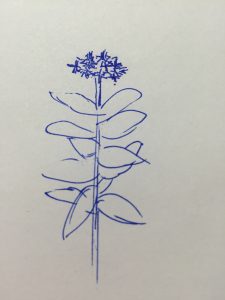
Scientific name: Rhodiola rosea
Common name: rose root / goldenroot
Family name: Crassulaceae
Type:Herbaceous perennial
USDA hardiness zone: 1-7
Form: well-standing; height: 20-30cm
Leaf: Toothed, light green
Flower: Small yellow flowers with 4 sepals and 4 petals
Ecological characteristics/requirements:
– Very hardy plant, prefers full sun and tolerates most types of well-drained soil
– Self-sows when growing in a favorable environment
Suitable uses: Used as ornamental in rock gardens. Valued as an herbal adaptogen.
Quick ID: Bright yellow flowers with bright green succulent leaves
Photographs:
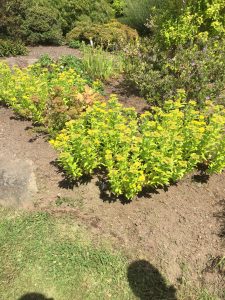
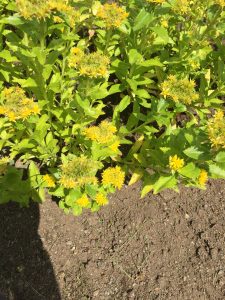
Sources of information:
https://www.richters.com/show.cgi?page=QandA/Commercial/20040807-1.html
http://homeguides.sfgate.com/cultivate-rhodiola-rosea-21776.html
Dr. P.K Gupta’s Clinic Sexologist in delhi fulfills all the categories that the best sexologist in delhi requires.